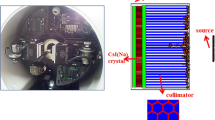Abstract
Objective
In a typical single photon emission computed tomography (SPECT) system, intrinsic spatial resolution depends on the accuracy of the identification of an interacting point, which is dominated by propagation of the scintillation photons in the detector block. This study was intended to establish a Monte Carlo simulation-based evaluation tool taking into account the propagation of scintillation photons to estimate the intrinsic spatial and energy resolutions of the position-sensitive scintillator block in a SPECT detector.
Methods
We employed Geant4 Monte Carlo simulation library which incorporated the optical photon processes for two different designs of the position-sensitive scintillator blocks. The validation of the simulation code was performed for a monolithic NaI(Tl) scintillator (251 × 147 × 6.4 mm3) coupled to 15 flat-panel type multi-anode photo multiplier tubes (PMT) (H8500: Hamamatsu) and results were compared with those obtained experimentally. The code was then applied to a LaBr3(Ce) scintillator of 120 mm square with varied thicknesses for designing high-resolution detector.
Results
The simulation resulted in 2.6 mm full width at half maximum (FWHM) of spatial resolution and 9.0% FWHM of energy resolution for the NaI(Tl)-based detector, which were in a good agreement of the experimental results, i.e., 2.7 mm and 10%, respectively. These findings suggest that Geant4 simulation including optical photon processes enables to predict the spatial and energy resolutions of a SPECT detector block accurately. The simulation also demonstrated that 2 mm spatial resolution can be obtained for a 6 mm thickness of the LaBr3(Ce), which is a significant improvement in performance as compared to existing gamma camera system that employs the scintillation detector fitted with PMTs.
Conclusions
The Monte Carlo simulation-based evaluation tool was established to estimate the intrinsic spatial and energy resolutions of SPECT detector with position sensitive PMTs. This simulation may be useful to provide an optimal design of a SPECT detector without physical experiments.









Similar content being viewed by others
References
Agostinelli S, Allison J, Amako K, Apostolakis J, Araujo H, Arce P, et al. GEANT4 a simulation toolkit. Nucl Instrum Methods Phys Res A. 2003;506:250–303.
Van Der Laan DJ, Dennis RS, Maas MC, Beekman FJ, Bruyndonckx P, van Eijk CWE. Optical simulation of monolithic scintillator detectors using GATE/GEANT4. Phys Med Biol. 2010;55:1659–75.
Sergio LM, Giuseppe B, Paolo B, Dante B, Valentino OC, et al. Optical physics of scintillation imagers by GEANT4 simulations. Nucl Instrum Methods Phys Res A. 2009;607:259–60.
Ciocia F, Braem A, Chesi E, Leo RD, Joram C, Lagamba L, et al. GEANT4 studies on the propagation and detection of scintillation light in long thin YAP crystals. Nucl Instrum Methods Phys Res A. 3009;600:506–12.
Wirth S, Metzger W, Pham-Gia K, Heismann BJ. Impact of photon transport properties on the detection efficiency of scintillator arrays. IEEE Nuclear Sci Symp Confer Record. 2006;2602–3
Soreefan AM, Hui T, DeVol TA, Dept. Experimental and monte carlo investigation of the light collection efficiency of heterogenous scintillation flow cell detectors. IEEE Nuclear Sci Symp Confer Record. 2003;760–2
Pani R, Pellegrini R, Cinti MN, Bennatia P, Bettia M, Vittorinia F, et al. LaBr3:Ce crystal: the latest advance for scintillation cameras. Nucl Instrum Methods Phys Res A. 2007;572:268–9.
Pani R, Cinti MN, Pellegrinia R, Bennatia P, Bettia M, Vittorinia F, et al. LaBr3:Ce scintillation gamma camera prototype for X and gamma ray imaging. Nucl Instrum Methods Phys Res A. 2007;576:15–8.
Zeniya T, Hirano Y, Sakimoto T, Ishida K, Watabe H, Teramoto T, et al. Conceptual design of high resolution and a quantitative SPECT system for imaging a selected small ROI of human brain. IEEE Nuclear Sci Symp Confer Record. 2009; 3484–6
Li C, Wang B, Wang R, Wang H, Zhu Z. First-principles study of the electronic and optical properties of lanthanide bromide. Thin Solid Films. 2008;516:7894–8.
Zeniya T, Watabe H, Inomata T, Iida H, A Sohlberg, H Kudo. 3DOSEM reconstruction from truncated data in pinhole SPECT. IEEE Nuclear Sci Symp Confer Record. 2007; 4205–7
Kudo H, Courdurier M, Noo F, Defrise M. Tiny a prior knowledge solves the interior problem in computed tomography. Phys Med Biol. 2008;53:2207–31.
Jaszczak RJ, Li J, Wang H, Zalutsky MR, Coleman RE. Pinhole collimation for ultra-high-resolution small-field-of-view SPECT. Phys Med Biol. 1994;39:425–37.
Maas MC, Schaart DR, Van Der Laan DJ, Bruyndonckx P, Lemaitre C, Beekman FJ, et al. Monolithic scintillator PET detectors with intrinsic depth-of-interaction correction. Phys Med Biol. 2009;54:1893–908.
Zhi Li, Wedrowski M, Bruyndonckx P, Vandersteen G. Nonlinear least-squares modeling of 3D interaction position in a monolithic scintillator block. Phys Med Biol. 2010;55:6515–32.
Acknowledgments
The authors would like to thank Mr. Hiroyuki Mashino of EspecTecno Corporation, Kobe, Japan, for his skillful assistance with an acquisition system of the detector. This work was supported in part by the Project from Kansai Bureau of Economy, Trade and Industry of Japan; a Grant for Research on Health Labour Sciences Research Grant, from the Ministry of Health, Labour and Welfare (MHLW) of Japan; the Budget for Nuclear Research of the Ministry of Education, Culture, Sports, Science and Technology (MEXT) of Japan; and the Grant-in-Aid for Scientific Research from MEXT of Japan.
Author information
Authors and Affiliations
Corresponding author
Rights and permissions
About this article
Cite this article
Hirano, Y., Zeniya, T. & Iida, H. Monte Carlo simulation of scintillation photons for the design of a high-resolution SPECT detector dedicated to human brain. Ann Nucl Med 26, 214–221 (2012). https://doi.org/10.1007/s12149-011-0561-4
Received:
Accepted:
Published:
Issue Date:
DOI: https://doi.org/10.1007/s12149-011-0561-4




